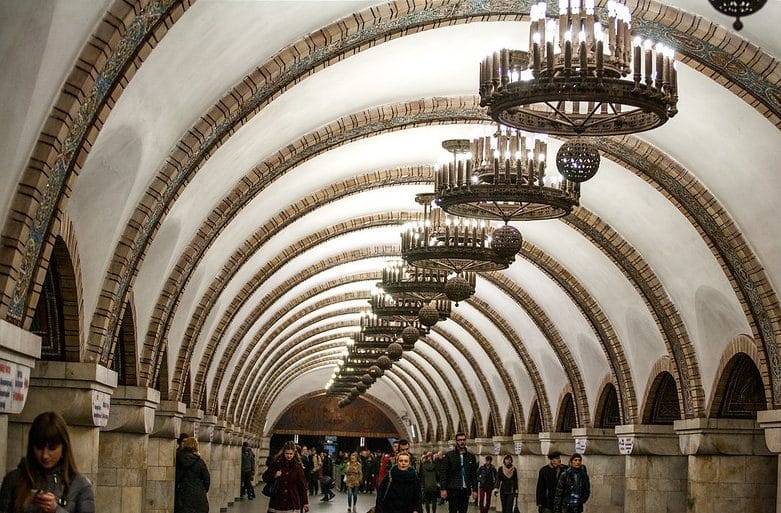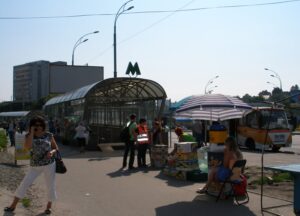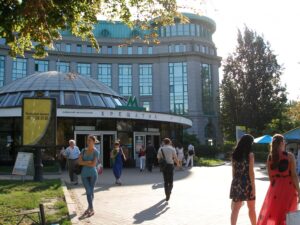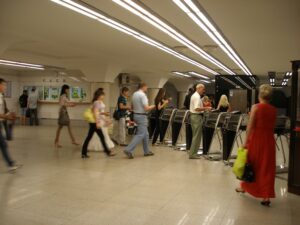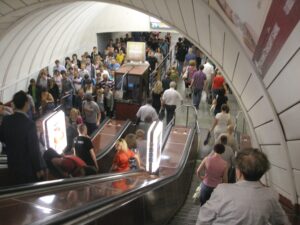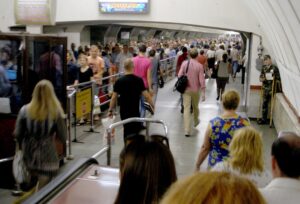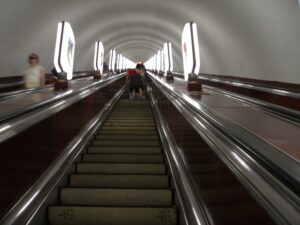Carrying well over a million passengers per day across 52 stations, Kyiv’s metro system is an integral part of the city’s daily life. While it has developed with the ever-growing city, like much of Ukraine’s public infrastructure, the metro system has struggled to keep up with the demands made of it. These demands are growing more pressing as car ownership has skyrocketed in the post-Soviet era, meaning that traffic congestion and pollution have become contentious problems. Today, although still a unique and generally beloved system with trains arriving about every minute at peak service times, the metro cars are often jammed with people as the train hurtles towards its next destination.
Early History of the Kyiv Metro
Kyiv’s metro first opened in 1960 but construction plans date back as early as 1884, when a railway entrepreneur suggested building tunnels extending from the rail station into the city. The city council turned down the proposal. In 1916, businessmen from the Russo-American Trading Corporation proposed a metro system. WWI caused the plans to be shelved. In 1935, Soviet planners proposed a three-line metro system which, for aesthetic and cost-saving reasons, would be only partly underground. The rest would use “upper tunnels” that would rise above ground level. This plan was deemed infeasible and never implemented. In a second proposal, Muscovites unfamiliar with Kyiv’s geography and demography proposed a circuitous system of metro lines that would have serviced areas with little development. This plan was also rejected.

Discussions continued through the pre-World War II period. A revised plan was created, one that better reflected Kyiv’s geography and population centers. This plan put the metro line underneath the main street (Khreshchatik) as well as through densely populated residential areas north and south of the city center. Preparatory work on a tunnel underneath the Dnieper River was initiated, but construction ceased when WWII began in 1941.
In 1944, the year after Kyiv was retaken from the Nazis, the Soviet government made a metro system part of its reconstruction plans for the city. Construction began again in 1949, but was plagued by delays. Kyiv’s underground aquifers proved a major challenge, and tunnels were constantly flooding. Funds were frequently running short as the USSR attempted to essentially rebuild the entire country and open new agricultural lands and build new industries all at once. Finally, Stalin’s death in 1953 and the resulting “thaw” and “de-Stalinization led by Khrushchev called into question the approved designs, which integrated communist imagery with local motifs. Some also argued that they gaudy. Those stations were redesigned in a new contest held in 1958. These used more utilitarian architectural styles, which were felt to better represent the mood and messaging of the time – and also the actual funds available for their construction.
1960: The Kyiv Metro Finally Opens
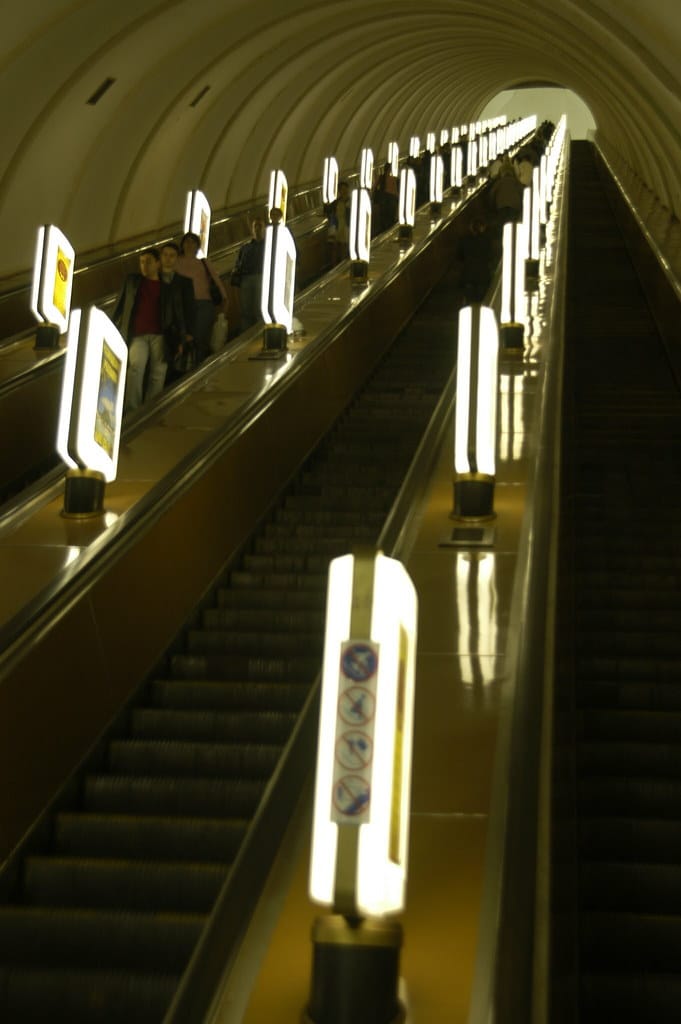
Picture from Photo from Nomad Tales
The metro finally opened in 1960 with five initial stations on what is today the red line. The grand opening was held on the anniversary of the October Revolution, although initially only people with specially-issued passes could ride. In the days after the official opening, school children and certain workers could ride the metro by special invitation. The metro opened to the public several months later. In the early days, inspectors were employed to check metro passes.
The metro has since continually expanded. From 1960-1974, the first line was extended in both directions. In 1972, a fifth carriage was added to each train, a sign of increasing usage. The blue line opened in 1976; the green line in 1989.
A total of 31 stations were constructed under the USSR. Many of the stations close to the city center are very deep, including Arsenalna, which is the deepest metro station in the world, down 350 feet. The depth occurred for two reasons. The first was to place the stations far enough under the water table so that it could not flood them. Second, these stations, like many throughout the USSR, were built to double as bomb shelters, lest the ongoing Cold War turn hot. Large metal doors allow many metro stations to be fully sealed off.
With independence came political and financial collapse. However, Kyiv continued to grow, as did demand for public transportation. Thus, 2003-2008 was a particularly active period of construction, despite challenges, and new stations were added to all three metro lines. Today, three additional metro lines are planned to open by 2025. Although most Kyivites might agree that the additional transport is needed, most are also skeptical whether this ambitious plan can be fully enacted given current financial and administrative resources.
The Metro in Modern Culture and Politics
The metro has also reflected Ukraine’s changing relationship to languages and geopolitical orientation. Under perestroika, announcements became bilingual: in both Russian and Ukrainian, responding to a simmering resurgence in national consciousness at that time. After independence, parliament discussed making Ukrainian Ukraine’s only state language in order to support Ukrainian culture over Russian, which had been the dominant culture of the USSR. Although that bill did not pass, Kyiv’s metro changed all signage and announcements to Ukrainian only.
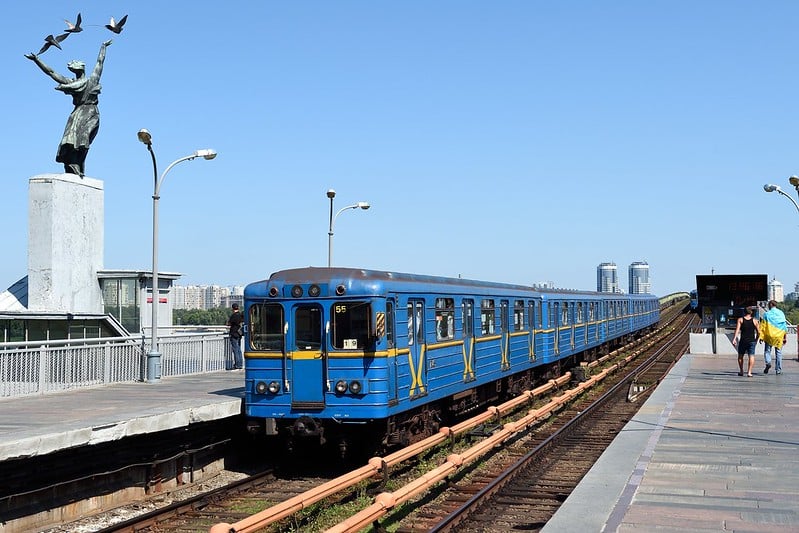
Ahead of the 2012 Euro soccer tournament, English announcements were added, which reflected not only an effort to accommodate a large surge in sport tourism, but also growing ties with Western Europe and the US in general.
Recently, Ukraine’s national “decommunization” efforts have gained headlines around the globe. However, this effort can be seen as already begun in the early 1990s, when nine stations were renamed from Communist-inspired names to names reflecting a more Ukrainian national identity. For instance, Red Army Station became known as Ukraine Station. When the full decommunization law passed in 2015, all remaining symbols of the USSR were removed from the metro system.
Kyivites pride themselves on the beauty of their metro. Each station has a different design, often relatedto its proximity to local landmarks or its name. Zoloti Vorota Station, near the reconstructed ancient gates that were the main entrance to the once-walled, ancient city, was named one of the most beautiful in the world by Business Insider for its detailed mosaics depicting the history of Kyivan Rus. Olimpiiska Station features Olympic rings and bike tire chandeliers. Minska Station features motifs from Belarussian culture, commemorating Ukraine’s friendship with its neighboring nation. In 2018, international and Ukrainian artists painted eight murals in Osokorky Station testifying to themes of national unity. Although crowding is a common and valid public complaint, the metro system is a point of pride, optimism, and architectural showmanship for Kyivites.
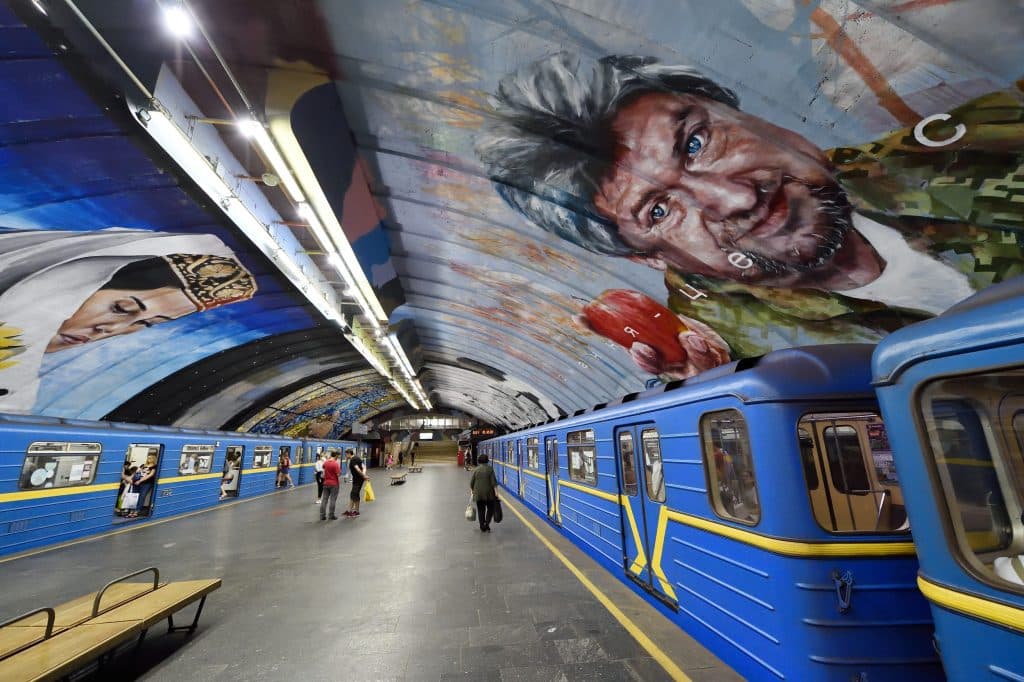
Today, metro stations are hubs for small businesses and individual vendors. Rarely does one emerge from a metro station without being offered something to buy, ranging from purses to children’s books. Many metro stations are located in underground, labyrinthine malls, where everything from souvenirs to cosmetic products to locks can be purchased. Some stations are adjacent to full underground supermarkets, while others are populated with small booths selling an eclectic collection of products. Outside of many metro stations, vendors selling flowers, especially tulips, are a frequent sight. As the winter turns to spring, other vendors sell gardening instruments and flower bulbs in preparation for dacha season. Metro stations provide the foot traffic necessary to support a variety of small businesses.
Often, metro stations are a good place to enjoy a free concert. Maidan Nezalezhnosti/Khreshchatyk Station often hosts an accordion player and a duo singing traditional Ukrainian songs. If you’re lucky, you can pause outside of Zoloti Vorota Station to listen to a lively guitar/violin duo serenade the park. Musicians add vivacious atmosphere to the metro stations.
The metro system is a fixture of Ukrainian life in Kyiv. Many Ukrainians depend on the metro system for reliable, cheap transport. Beyond its practical and historical uses, the metro system serves as a cultural and economic amenity. Unique designs make Kyiv metro stations architectural monuments lauded the world over. The omnipresent vendors and musicians make the Kyiv metro system a lively hub of commerce and local culture.
The above article written by R.A. Bloomfield
Riding the Kyiv Metro Today
By Marie Forney (written 2013, updated 2021)
If you make a trip to Kyiv, you’ll inevitably encounter the city metro system, and it can be a bit intimidating at first, especially given the system’s magnitude, large quantity of passengers, and high speed. But becoming acquainted with some operational practices and navigation guidelines can turn your metro experience into an enjoyable, easy, and efficient way to travel the city and immerse yourself in some culture of Kyiv. While city busses, trolley-busses, and taxis also provide transportation in Kyiv, the metro system is arguably the most popular, cleanest, safest, and easiest way to traverse the metropolitan area at a low cost.
Transfer sites: There are three intersections, or “transfer,” locations in the central area of Kyiv, where passengers may switch from one line to another: Blue ↔ Red, Green ↔ Red, and Blue ↔ Green. These transfer stations are connected to one another underground, so passengers may follow signs through subterranean passageways to change from one railway to an intersecting one. These transfer stations are the most crowded portions of the metro system and can seemingly resemble the herding of cattle during rush hours between about 8:30-10:00am and 4:30-6:30pm. Expect extreme crowding with your fellow passengers if you use these stations at peak commuting times.

Fares: A single trip within the system costs 8 грн ($0.30), and admittance to the trains is granted through the purchase of either blue plastic tokens or contactless cards. The blue tokens are each good for one trip and can be purchased from cashiers or automatic token machines located at each station. The electronic dispensaries change 2- and 10-грн bills for tokens which can be inserted into turnstiles that permit passage to the trains.
Contactless cards allow passengers to “load” prepaid trips onto a card which can be “refilled” with subsequent purchases and scanned at the turnstiles. Unlimited half-month and month plans can also be programmed onto a contactless card. This allows passengers to use the card as many times as he/she wishes within the allotted time-period. Note that these plans put a lock on the card for seven minutes after every use in order to prevent abuse.
NovaMova (the school through which SRAS classes are held) conveniently included a monthly pass as part of my study and home-stay program.
Some tips, cautions, and interesting facts:
Traffic: The Kyiv metro accommodates over 1.4 million passengers each day, carrying 38% of all public transportation in the city through 50 stations. Over 600 cars cover more than 40 miles of track. Trains move fast, don’t stop for very long at stations, and get extremely crowded at certain times and locations. The number of trains running at a given time and the distance between them depends on the time of day. During rush hours, trains follow one another at intervals of about a minute or less. During lower traffic times, trains may run five to ten minutes apart.
Hold on: The trains accelerate and decelerate very rapidly, which means that if you’re not sitting down, it would be very wise to hold onto one of the provided hand rails. If you’re unable to reach a hand rail because the car is too crowded, spread your feet apart in a wide stance so that you are facing the side of the car and adjust the distribution of your weight as the car moves so you don’t fall over. It is normal to see people stumbling as the trains start and stop, but it doesn’t seem to be much appreciated when people fall onto one another. (Again, I’m speaking from my own experiences.)
Public displays of affection: The metro system seems to be a prime venue for demonstrations of affection to significant others, so don’t be surprised if you regularly see a lot of smooching and caressing on the cars, platforms, and escalators.
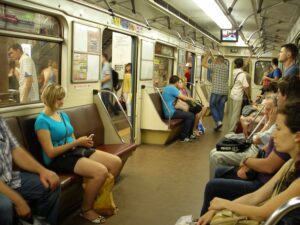
Bags and seats: If you are carrying any kind of bag, hold it close to your front while on the cars to prevent pick-pocketing and inconveniencing other passengers. Although it is not expected that you give up your seat to the elderly, children, and women, it is always greatly appreciated.
Long escalators: Arsenalna station (Red Line) is the deepest metro station in the world at 105.5 meters, and other stations follow close behind in depth. Sets of long escalators and stairs lead to and from the ground level to these stations (Some stations, however, are above ground). Some people sit on the escalators during non-peak hours, but I don’t recommend this practice, since the stairs are not clean. Generally, if it is not extremely crowded, people will form a single-file line on right side of the escalator and allow fast-moving stair-climbers to pass on the left. Rushed individuals seem to appreciate this while getting a bit of a workout in transit to their destination.
Serious faces: Unless people are traveling together, they do not seem to engage in friendly conversation with other passengers. I’ve managed to get some smiles out of kids and folks who thank me for my seat, but otherwise it seems to be the norm to remain outwardly dispassionate while riding the public transportation.
Nevertheless, riding the Kyiv metro can be an incredibly enjoyable adventure – both a means and an ends to experiencing the city, its history, people, and culture.


